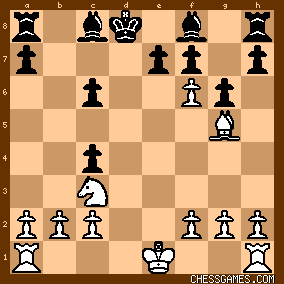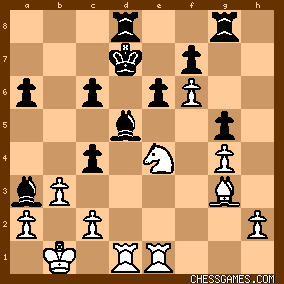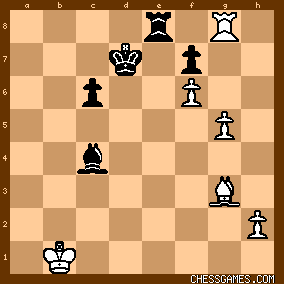| KEG: This game is a tragicomedy. Burn mishandled the opening and was probably lost by about move 8. He managed to simplify down to a Bishops of opposite colors ending down a pawn in which he could almost certainly have drawn with ease. Incredibly, somehow Rosen managed to lose this drawn endgame though up a pawn! After 8. e5, White had a small advantage, and--as noted by Coutinho on this site and by Rosenthal in the Tournament Book--8...dex5 would have been crushed by 9. Bxf7+. But Burn's 8...d5, though nowhere nearly as bad as 8...dxe5, was not best. (He should have played 8..Ng4). After 9. exf6 dxc4, Rosen would have had a winning advantage after 10. Qf3, the move recommended by Rosenthal. Even after the less accurate 10. QxQ+ KxQ 11. Bg5, Burn was in trouble. His Queen-side pawn structure was a disaster, and White's pawn on f6 was causing him major headaches: 
click for larger viewBurn should here have played 11...Kc7, since 12. fxe7 Bxe7 13. BxB allows 13...Re8 regaining the piece with a much better position than in the game. (Rosen would likely have played 12. 0-0-0 after 11...Kc7 and then 12...exf6 would have been much better than the text for Burn). Instead, Rosen played 11...Be6 and after 12. 0-0-0+ Ke8 Rosen could have had a dominating and probably winning game with 13. Ne4 (as recommended by Rosenthal in the Tournament Book). But played 13. f4 and now Burn was able to get back in the game with 13...h6, 14...Rg8 and 15...g5. After Burn's 22...Rad8, the position was as follows: 
click for larger viewHad Rosen here played 23. bxc3, Burn would have had an immediate draw by perpetual check with 23...Rb8+ 24. Ka1 Bb2+. The only serious chance to play for a win here would have been 23. Rd4. Rosen's actual move, 23. Re3, allowed Burn to exchange down to a drawn Bishop of opposite colors endgame. After Burn's 36...Re8, the game appeared to be as good as drawn: 
click for larger viewAmazingly enough, Rosen (White) managed to lose this position. I will recount how this happened in my next post on this game. | 




